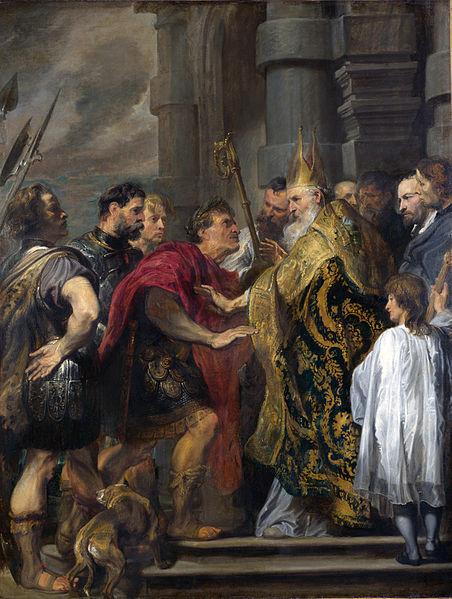An antiphon is a short chant in Christian ritual, sung as a refrain. The texts of antiphons are usually taken from the Psalms or Scripture, but may also be freely composed. Their form was favored by St Ambrose and they feature prominently in Ambrosian chant, but they are used widely in Gregorian chant as well. They may be used during Mass, for the Introit, the Offertory or the Communion. They may also be used in the Liturgy of the Hours, typically for Lauds or Vespers.
The Liber responsorialis, showing on the right-hand page the antiphons for the first night office of Christmas. The associated psalm tones are indicated by number and ending pitch, and the pitches for the ending of the doxology are indicated by the mnemonic Euouae.
The Annunciation
Ambrose of Milan, venerated as Saint Ambrose, was a theologian and statesman who served as Bishop of Milan from 374 to 397. He expressed himself prominently as a public figure, fiercely promoting Roman Christianity against Arianism and paganism. He left a substantial collection of writings, of which the best known include the ethical commentary De officiis ministrorum (377–391), and the exegetical Exameron (386–390). His preachings, his actions and his literary works, in addition to his innovative musical hymnography, made him one of the most influential ecclesiastical figures of the 4th century.
Detail from possibly contemporary mosaic (c. 380–500) of Ambrose in the Basilica of Sant'Ambrogio
Relief by Vuolvino [it] depicting Ambrose as a child while bees swarm his crib. His father is on the right of the image while the sky has three clouds "sending forth flames". The relief is from the Altar of Sant'Ambrogio in the Basilica of Sant'Ambrogio.
Saint Ambrose barring Theodosius from Milan Cathedral a "pious fiction" painted in 1619 by Anthony van Dyck. National Gallery, London
Embossed silver urn with the body of Ambrose (with white vestments) in the crypt of Sant'Ambrose, with the skeletons of Gervase and Protase




![Relief by Vuolvino [it] depicting Ambrose as a child while bees swarm his crib. His father is on the right of the image while the sky has three clouds](https://upload.wikimedia.org/wikipedia/commons/thumb/e/e7/Altare_di_s._ambrogio%2C_824-859_ca.%2C_retro_di_vuolvino%2C_storie_di_sant%27ambrogio_06_miracolo_delle_api.jpg/640px-Altare_di_s._ambrogio%2C_824-859_ca.%2C_retro_di_vuolvino%2C_storie_di_sant%27ambrogio_06_miracolo_delle_api.jpg)

